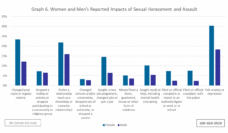The #MeToo movement demonstrates that sexual harassment and assault are common across the globe. Both the #MeToo movement and the current cases of sexual assault on college campuses focus on adult perpetrators and survivors. But sexual harassment among teenagers may be even more common than sexual harassment among adults. Between 30 and 45% of high schoolers in the US report being sexually harassed in the past year.
Middle school and high school students may feel that it is normal to perpetuate sexual harassment behavior because they see their friends and peers doing it. Additionally, younger victims of sexual harassment may not realize that what has happened to them is considered harassment. Up to 14% of students who have been victimized reported their experiences were “not really sexual harassment” because the incident was “meaningless” or intended as a joke. Sexual harassment among youth leads to poor academic performance, anxiety, depression, and substance use-related problems, and these effects occur whether or not the victimized student feels as if the incident was harassment.
Limited research has been conducted on the environmental risk factors for victimization and perpetration. Elizabeth Mumford, Nnenna Okeke, and Emily Rothman recently examined potential neighborhood-level risk factors for sexual harassment perpetration among a nationally representative sample of males between the ages of 10 and 18.
By focusing on the perpetration of sexual harassment, experts can develop interventions that stop sexual harassment from occurring in the first place.
The researchers hypothesized that young men who lived in neighborhoods that had low gender equality, low advantage, and high neighborhood crime would be likely to perpetrate sexual harassment. Neighborhood advantage was determined by the percentage of the residents living in poverty, receiving public assistance, and with less than a high school education. Neighborhood gender equality was measured by the female-to-male ratio of income, college degrees, and managerial positions.
Contrary to the researchers’ hypotheses, neighborhood crime and low gender equality were not associated with harassment perpetration. The only neighborhood-level variable that predicted sexual harassment was neighborhood advantage. Young men in neighborhoods with high advantage were more likely to sexually harass than those from neighborhoods with low advantage. The authors speculate that young men with privileged backgrounds feel entitled to perpetrate sexual harassment.
Violence prevention experts at the Centers for Disease Control and Prevention have focused on reducing perpetration for over a decade. By focusing on the perpetration of sexual harassment, experts can develop interventions that stop sexual harassment from occurring in the first place. Rothman told Public Health Post, “If we only focus on victimization, we are in a way ‘victim blaming’ by only thinking about what people could do to decrease their risk. This presumes that those victimized are somehow in control of if they’re victimized or not.”
Identifying the environmental risk factors for sexual harassment serves as an important step to prevent it from happening. Rothman said that this research “shines a spotlight on the fact that we should be doing more to hold young men with privilege accountable. We need social norm change campaigns that change parental attitudes and neighborhood-wide acceptance of harassing behavior” to alleviate the harmful effects of this public health emergency.
Photo via Getty Images
If you have been affected by sexual violence and wish to speak with your nearest sexual assault service provider, call the National Sexual Assault Telephone Hotline (RAINN) at 1-800-273-8255 or visit rainn.org.














